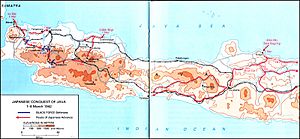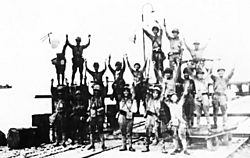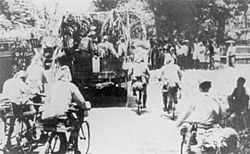Battle of Java (1942) facts for kids
Quick facts for kids Battle of Java |
|||||||
|---|---|---|---|---|---|---|---|
| Part of World War II, Pacific War | |||||||
 Map depicting Allied defensive lines (in blue) and the movement of Japanese forces (red) in Java, 1–8 March 1942. |
|||||||
|
|||||||
| Belligerents | |||||||
| Commanders and leaders | |||||||
|
|
|||||||
| Strength | |||||||
|
34,250 |
|||||||
| Casualties and losses | |||||||
| Netherlands: unknown Great Britain: unknown Australia: 36 killed 60 wounded United States: 825 killed 1,067 captured (US Army: 24 killed, 534 captured. US Navy: 801 killed, 369 captured. 165 prisoners later died in captivity.) |
unknown | ||||||
The Battle of Java was a major land battle during World War II in the Pacific Ocean. It took place on the island of Java from February 28 to March 12, 1942. This battle was part of a larger plan by the Empire of Japan to take control of the Dutch East Indies (modern-day Indonesia).
Japanese forces invaded Java on February 28, 1942. They faced Allied soldiers from the Netherlands, Great Britain, Australia, and the United States. The battle ended with the Allied commanders signing a formal surrender on March 12, 1942. This victory gave Japan control over important resources in the region.
Contents
Who Fought in the Battle of Java?
The main groups fighting in the Battle of Java were the Japanese and the Allies. The Allies had formed a special command called the American-British-Dutch-Australian Command (ABDA).
The Allied Forces (ABDA)
The Allied forces were led by Lieutenant-General Hein ter Poorten from the Royal Netherlands East Indies Army (KNIL). Even though the KNIL had about 25,000 troops, many were not well-trained. Most of these soldiers were from Indonesia.
- Dutch Forces: The KNIL troops were spread out across Java. They defended areas like Batavia, central Java, south Java, and east Java.
- British Forces: Around 5,500 British soldiers were on Java. Many of them were anti-aircraft units, meaning they were trained to shoot down enemy planes. The British also had a small group of light tanks.
- Australian Forces: About 3,000 Australian soldiers were part of a group called "Blackforce." This group was led by Brigadier Arthur Blackburn. They were well-equipped with machine guns and trucks but lacked many other weapons.
- United States Forces: The only U.S. ground troops were about 750 soldiers from the 131st Field Artillery. This unit was also part of Blackforce.
The Japanese Forces
The Japanese forces were part of the 16th Army, led by General Hitoshi Imamura. They were well-trained and had more soldiers than the Allies.
- The Japanese forces were divided into two main groups.
- The Eastern Force included the 48th Division.
- The Western Force included the 2nd Division.
- These divisions had many infantry soldiers and also tank units.
Japanese Landings on Java
The Japanese began their invasion of Java on March 1, 1942. They landed troops at three different places.
- One group landed in West Java at Bantam Bay and Eretan Wetan. This group had just fought in the Battle of Sunda Strait before landing.
- Another group landed in East Java at Kragan. They had defeated the Allied fleet in the Battle of the Java Sea before their landing.
The West Java Campaign
The Japanese Western Force aimed to capture key cities and cut off Allied escape routes.
Fighting Near Merak and Bantam Bay
The Japanese Western Force, led by Lieutenant General Hitoshi Imamura, left Cam Ranh Bay on February 18. Their goal was to attack Java.
- On February 28, Japanese transport ships began landing troops at Merak and Bantam Bay.
- A small Dutch unit tried to stop them but was quickly defeated.
- By March 1, the Japanese had set up their headquarters at Serang.
Japanese Advance and Allied Retreat
The Japanese 2nd Division split into different groups to attack various targets.
- One group, the Nasu Detachment, was ordered to capture Buitenzorg. This would cut off the escape route from Batavia to Bandoeng.
- Other Japanese groups headed towards Batavia.
- On March 2, the Nasu Detachment reached Rangkasbitung. They met strong resistance from Australian and U.S. troops at Leuwiliang.
- The Allied forces fought hard for two days, destroying many Japanese tanks and trucks.
- However, the Allies had to retreat to Soekabumi to avoid being surrounded.
- On March 4, the Allied commander, Ter Poorten, decided to pull his forces out of Batavia and Buitenzorg. This was to strengthen the defense of Bandoeng.
- Dutch troops in Batavia surrendered on March 5.
- By March 6, the Japanese had occupied Buitenzorg. Many Allied soldiers retreated to Bandoeng.
- Japanese troops entered Bandoeng on March 9.
Campaign from Eretan Wetan
Another Japanese unit, the 3rd mixed Regiment, landed at Eretan Wetan on March 1. Their main goal was to capture the important Kalidjati airfield.
- Allied planes tried to attack the Japanese troops at Eretan Wetan.
- The Japanese quickly advanced and captured the Kalidjati airfield.
- The loss of this airfield worried the Dutch, who launched a counterattack on March 2.
- A Dutch armored unit with about 20 tanks tried to push back the Japanese.
- The attack failed, and more Japanese air forces arrived at Kalidjati airfield.
- By March 7, Japanese troops were close to Bandoeng.
- On March 8, the Dutch commander of the Bandoeng area surrendered to the Japanese.
The East Java Campaign
The Japanese Eastern Force, the 48th Division, came from the Philippines.
Moving Eastward Across Java
- On February 27, the Japanese fleet fought and won the Battle of the Java Sea.
- On March 1, the Japanese landed at Kragan, a small village in East Java.
- A small Dutch cavalry unit tried to stop them but was quickly defeated.
- Allied planes, including U.S. bombers, tried to attack the Japanese invaders.
- After landing, the 48th Division split into several units.
- Some units were ordered to capture oilfields at Tjepoe and Bodjonegoro.
- They also planned to attack Surabaya from two directions.
- The Japanese quickly captured Tjepoe on March 2 and Bodjonegoro on March 3.
- They continued to advance, overcoming Dutch defenses in many towns.
- Near Surabaya, Dutch and American troops put up strong resistance.
- However, the Allied troops had to retreat to the island of Madura.
- On the evening of March 9, the Dutch commander in East Java signed the surrender.
Moving Southward to Tjilatjap
Another Japanese group, the Sakaguchi Detachment, also landed in East Java.
- They split into three units and moved south.
- Their goal was to capture Tjilatjap, an important harbor. This would stop Allied troops from escaping to Australia.
- They advanced very quickly, overcoming Dutch defenses in many towns.
- By March 8, they captured Keboemen and Purwokerto, north of Tjilatjap.
- Other units entered Tjilatjap on March 8.
- The Dutch had already pulled back from Tjilatjap.
- On March 9, the Dutch Central Army District commander surrendered his troops to the Japanese.
Allied Surrender and Aftermath
By March 7, it was clear that the Allies would lose the battle. Japanese troops were closing in on Bandoeng from all sides.
- At 9:00 AM on March 8, the Allied Commander-in-Chief, Ter Poorten, announced the surrender of the Royal Netherlands East Indies Army in Java.
- Later that day, the Dutch Governor and Lieutenant-General Ter Poorten met with the Japanese Commander-in-Chief, Lieutenant-General Hitoshi Imamura.
- They agreed to the surrender of all Allied troops.
- The Dutch radio station broadcast its last news, ending with "We are closing now. Farewell till better times. Long live the Queen!"
What Happened Next?
- On March 10, Lieutenant-General Hitoshi Imamura became the new governor of Java and Madura. He was in charge of the occupied Dutch East Indies.
- On March 12, the senior British, Australian, and American commanders formally signed the surrender papers in Bandoeng.
- The Japanese commander promised to treat the prisoners of war according to the Geneva Convention.
- After the battle, the Japanese reorganized their troops. The 16th Army stayed to guard Java. Other units were sent to different battle areas or returned to Japan.
- The surrender of the Dutch forces meant the end of Allied defense in the Dutch East Indies.
- It also meant that the Indian Ocean and the path to Australia were now open to the Japanese Navy.
Images for kids
-
An MkV1B light tank of the 3rd Hussars disembarks at Sumatra on 14 February 1942.
See Also
- Lost Battalion (Pacific, World War II)





